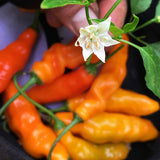Ají Amarillo (Peruvian Chile)
Capsicum baccatum
This pepper is native to the Andes (Bolivia or Peru) and has been called the most important ingredient in Peruvian cuisine as it is the cornerstone to many essential traditional dishes. While Peru has the largest diversity of peppers in the world, this species (Capsicum baccatum), and this variety in particular, is the most popular. It is hot, sweet, and fruity. When dried, it is called Ají Mirasol or Cusqueno. On the plants, the young fruits start out green, turn yellow, and ripen this fiery orange. When cooked, the fruit turns yellow, hence the name. Consider pairing with our Huacatay (Peruvian Marigold leaves) for a delicious flavor combination in sauces, ceviche, and dishes like Papas al Huancaína!
Days to maturity: 90-100
Seeds per pack: 25
Germination rate: 96% on 01/24/2025
Planting / harvesting notes
Start seeds indoors 8-10 weeks before the last frost and transplant into garden well after the danger of frost. Keep seedlings moist but do not overwater. Transplants should be initially watered in well, and plants will be most productive with regular irrigation and full sun. These abundant, lanky plants may have to be staked.
Seed keeping notes
Peppers are generally self-pollinating, though we isolate different varieties of the same species by at least 50 feet, in hopes that flying insects will not cross pollinate them unexpectedly. There are several important species of peppers, so check your scientific names! Pepper seeds are ripe when the fruits have turned their final fiery color - in this case, fiery-orange. Cut the fruit, scrape out seeds, and lay them out to dry on a labeled screen or paper product in a ventilated place away from direct sunlight for a week or two. Consider wearing gloves for your protection! Drying the peppers before seed extraction can slightly lower your germination rates, but works fine for home seed saving as long as the peppers do not rot.
Other names: Aji Amarillo, Aji Mirasol, Peruvian Yellow Pepper, Aji Escabeche, Cusqueno, Cusqueño, Huancaína.






